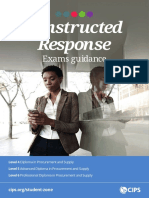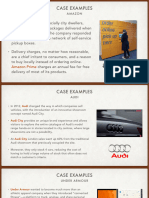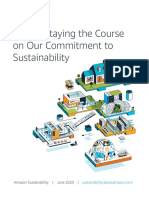0 ratings0% found this document useful (0 votes)
561 views196 pagesD2 Cips
Uploaded by
Ram PowruCopyright
© © All Rights Reserved
We take content rights seriously. If you suspect this is your content, claim it here.
Available Formats
Download as PDF or read online on Scribd
0 ratings0% found this document useful (0 votes)
561 views196 pagesD2 Cips
Uploaded by
Ram PowruCopyright
© © All Rights Reserved
We take content rights seriously. If you suspect this is your content, claim it here.
Available Formats
Download as PDF or read online on Scribd
You are on page 1/ 196
Defining
Business Need
[L4mz2]
Core
Study Guide
Level 4
Diploma in Procurement
and Supply
Printed and distributed by:
The Chartered Institute of Procurement & Supply, Easton House, Easton on the Hill, Stamford, Lincolnshire
PEO 3NZ
info@cips.org
www.cips.org
Copyright © CIPS 2018. All rights reserved
‘No part of this publication may be reproduced, stored in a retrieval system, rented, hired, transmitted in any
form or by any means, electronic, mechanical, photocopying, recording or otherwise, without permission in
writing from the publisher or under licence from the Copyright Licensing Agency Limited. Further detalls of such
licences (for reprographic reproduction) may be obtained from the The Copyright Licensing Agency, Sth Floor,
Shackleton House, 4 Battlebridge Lane, London, SE1 2HX.
Every attempt has been made to ensure the accuracy of this study guide; however, no liability can be accepted
for any loss incurred in any way whatsoever by any person relying Solely on the information contained within
it The study guide has been produced solely for the purpose of professional qualification study and should
not be taken as definitive of the legal position. CIPS cannot be held responsible for the content of any website
‘mentioned in this study guide. Specific advice should always be obtained before undertaking any investment.
ISBN: 978-1-86124-289-1
ACIP (Catalogue in Publication) catalogue record for this publication is available from the British Library.
All facts are correct at time of publication.
Author: Stephen Carter BSc MBA
First published in 2019 by CIPS
Editorial and project management by Haremi Ltd.
‘Typesetting by York Publishing Solutions Pvt. Ltd., INDIA
Index by York Publishing Solutions Pvt. Ltd,, INDIA
Every effort has been made to trace all copyright holders, but if any have been inadvertently overlooked, the
Publishers will be pleased to make the necessary arrangements at the first opportunity.
Printed and distributed by:
The Chartered Institute of Procurement & Supply, Easton House, Easton on the Hill, Stamford, Lincolnshire
PEO 3NZ
info@cips.org
www.cips.org
Copyright © CIPS 2018. All rights reserved
‘No part of this publication may be reproduced, stored in a retrieval system, rented, hired, transmitted in any
form or by any means, electronic, mechanical, photocopying, recording or otherwise, without permission in
writing from the publisher or under licence from the Copyright Licensing Agency Limited. Further detalls of such
licences (for reprographic reproduction) may be obtained from the The Copyright Licensing Agency, Sth Floor,
Shackleton House, 4 Battlebridge Lane, London, SE1 2HX.
Every attempt has been made to ensure the accuracy of this study guide; however, no liability can be accepted
for any loss incurred in any way whatsoever by any person relying Solely on the information contained within
it The study guide has been produced solely for the purpose of professional qualification study and should
not be taken as definitive of the legal position. CIPS cannot be held responsible for the content of any website
‘mentioned in this study guide. Specific advice should always be obtained before undertaking any investment.
ISBN: 978-1-86124-289-1
ACIP (Catalogue in Publication) catalogue record for this publication is available from the British Library.
All facts are correct at time of publication.
Author: Stephen Carter BSc MBA
First published in 2019 by CIPS
Editorial and project management by Haremi Ltd.
‘Typesetting by York Publishing Solutions Pvt. Ltd., INDIA
Index by York Publishing Solutions Pvt. Ltd,, INDIA
Every effort has been made to trace all copyright holders, but if any have been inadvertently overlooked, the
Publishers will be pleased to make the necessary arrangements at the first opportunity.
Contents «
Compare the competitive forces that influence markets 84
+ Bargaining strength of buyers and suppliers 88
+ Availabilty of substitutes and threat of entry 92
Contrast the breakdown between direct and indirect costs and the types of data
that can provide information on cost and price 97
+ How to collate sources of information to estimate the breakdown of costs between
direct and indirect costs for purchased goods and services 98
+ How to use information to prepare budgets or to negotiate prices 103
+ How to research and use market data to estimate and negotiate current and
future prices and costs for purchased goods and services 106
Chapter 3
(©) _ Understand the use of specifications in procurement and supply 15
Analyse different types of specifications used in procurement and supply and
sources of information that can be used to create specifications 116
+ Drawings, samples, branded, technical 116
+ Conformance specifications 118
+ Output or outcome, statement of work based specifications 119
+ Standards 125
+ The Internet 125
+ Suppliers 126
+ Directories 130
Identify sections of specifications for through-life contracts 130
+ Scope 131
+ Definition 132
+ Description of requirement 133
+ Testing and acceptance 134
+ Change controt mechanisms and remedies 135
+ Social and environmental criteria 137
Identify the risks that can result from inadequate specifications and
mitigation approaches 140
+ Under- and over-specified need 140
+ How to monitor specification creation by colleagues and other internal stakeholders 146
Identify opportunities to regulate short- and longer-term specifications 150
+ How to implement standardisation 150
+ Value analysis 160
+ Value engineering im
+ How to provide guidance to internal stakeholders on implementation 173
Glossary 7
Index 183
+ Your qualification
Your
qualification
CIPS qualifications are regulated internationally to ensure we offer a recognised, professional
standard in procurement and supply. CIPS Level 4* Diploma in Procurement and Supply is
‘avocationally related professional qualification. Formal recognition is included within the
regulatory frameworks of an increasing number of countries such as the UK (England, Wales
and Northern irefand), UAE (including Dubai) and Africa (including Zambia). Further information
on this recognition and the details of corresponding qualifications levels for other international
qualifications frameworks are detailed on our website. CIPS members can have the confidence
in our regulated qualifications, which reliably indicate the standard of knowledge, skills and
understanding that you, as a learner, are required to demonstrate.
‘Astep up from the Level 3 Advanced Certificate in
Procurement and Supply Operations, the Level 4 Diploma in
Procurement and Supply sa stepping stone to study on the
‘CPS Level Advanced Diploma in Procurement and Supply.
The content has beer waitten using the CIPS Procuresnent
and Supply Cycle as its focus, which presents a cyclical
process of key steps faced by those procuring goods or
service. The Diploma offers the most common entry route
to the profession and should be used by leamers to develop
professional tool bax which learners can apply in the
practical environment and further develop at Levels and 6
Eon tevel
lnthis way successful earers wl posses rnserable workplace
skill, developing ther operational an tactical abies as they
stv for managerial roles and responses. Ris aimed a those
inthe profession who have procurement and supply aly
atthe heart of thai rle. Learns wil be expected to prow
acice and guidance to key stakeholders onthe performance
of organisational procedures and processes associated
with proarernent and supply and wll aspire to manage
You might also like
- Business Needs in Procurement and Supply - CIPS100% (9)Business Needs in Procurement and Supply - CIPS212 pages
- L4M1 Scope and Influence of Procurement and Supply Lesson Plan100% (3)L4M1 Scope and Influence of Procurement and Supply Lesson Plan50 pages
- Diploma in Procurement and Supply: Power Up Your Career67% (3)Diploma in Procurement and Supply: Power Up Your Career38 pages
- Advanced Certifıcate in Procurement and Supply Operations: 2018 Syllabus100% (1)Advanced Certifıcate in Procurement and Supply Operations: 2018 Syllabus20 pages
- Marked Exam Answers With Assessor Feedback100% (3)Marked Exam Answers With Assessor Feedback18 pages
- CIPS L4 - 5 - 6 - CR - Exam - Guide - UPDATE - 1019 - v2100% (1)CIPS L4 - 5 - 6 - CR - Exam - Guide - UPDATE - 1019 - v26 pages
- CIPS - L5 - StudSupp - OPS - MAN - V2operations Management100% (3)CIPS - L5 - StudSupp - OPS - MAN - V2operations Management57 pages
- Negotiating & Contracting in Procurement and Supply - D4100% (8)Negotiating & Contracting in Procurement and Supply - D4238 pages
- CIPS L5M4 Advanced Contract & Financial Management - LO1 1.1 1.2 1.3 and 1.4 PDF100% (1)CIPS L5M4 Advanced Contract & Financial Management - LO1 1.1 1.2 1.3 and 1.4 PDF12 pages
- CIPS Level 4 Diploma in Procurement and Supply: Module Title: Ethical and Responsible Sourcing (L4M4)100% (1)CIPS Level 4 Diploma in Procurement and Supply: Module Title: Ethical and Responsible Sourcing (L4M4)37 pages
- Introducing Level 4 Diploma in Procurement and SupplyNo ratings yetIntroducing Level 4 Diploma in Procurement and Supply3 pages
- L4M1 Scope and Influence of Procurement and Supply100% (1)L4M1 Scope and Influence of Procurement and Supply4 pages
- CIPS L5M4 ACFM Key Definitions, Formulas & L5M4 Learning Outcomes100% (1)CIPS L5M4 ACFM Key Definitions, Formulas & L5M4 Learning Outcomes25 pages
- CIPS L5M4 - LO4 Questions and Sample Answers100% (4)CIPS L5M4 - LO4 Questions and Sample Answers13 pages
- Question & Answers: Commercial Contracting100% (2)Question & Answers: Commercial Contracting13 pages
- Teaching Notes: CIPS Level 4 Diploma in Procurement and Supply83% (6)Teaching Notes: CIPS Level 4 Diploma in Procurement and Supply32 pages
- L4M4 EXAM MEMORANDUM-Ethical and Responsible Sourcing Mock100% (6)L4M4 EXAM MEMORANDUM-Ethical and Responsible Sourcing Mock11 pages
- (NO-1) Updated CIPS L4M1 Exam Questions 2025No ratings yet(NO-1) Updated CIPS L4M1 Exam Questions 202512 pages
- L4M7 Whole Life Asset Management Case Study: Leading Global Excellence in Procurement and Supply100% (1)L4M7 Whole Life Asset Management Case Study: Leading Global Excellence in Procurement and Supply4 pages
- L4M2 Focus Areas and Questions - 240610 - 180346100% (2)L4M2 Focus Areas and Questions - 240610 - 180346236 pages
- The Top 15 Supply Chain Metrics & KPIs For Your DashboardsNo ratings yetThe Top 15 Supply Chain Metrics & KPIs For Your Dashboards19 pages

































































